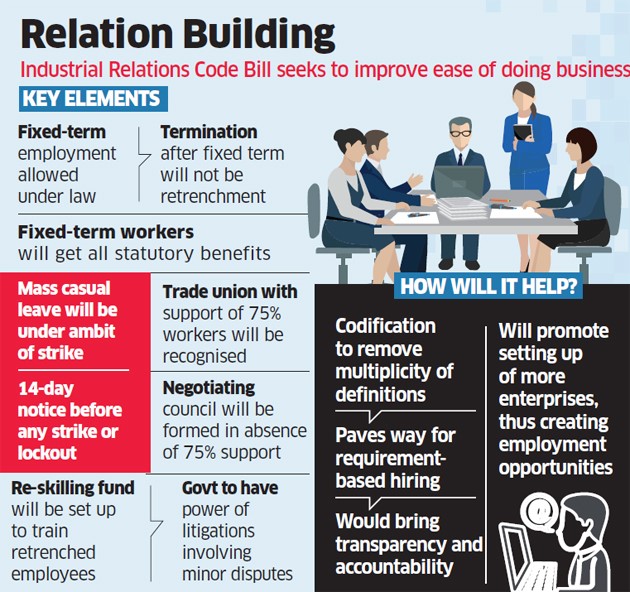When people ask me, "Why can't labor organize the way it did in the thirties?'
the answer is simple: everything we did then is now illegal.
— Thomas Geoghegan
the answer is simple: everything we did then is now illegal.
— Thomas Geoghegan
The government of India had begun the long overdue modernisation of labour laws to improve the ease of doing business in India and achieve the aim of reaching $5 trillion economy, because the rigidity of labour laws about laying off labour were often cited as the main reason limiting the scalability and employment generation
 in India. The new codes will help raise incomes and social security levels for the 90 percent of India's workers who are employed in the informal sector, and will also help businesses become more competitive and boost an economy that is showing signs of a slowdown.
in India. The new codes will help raise incomes and social security levels for the 90 percent of India's workers who are employed in the informal sector, and will also help businesses become more competitive and boost an economy that is showing signs of a slowdown.The Industrial Relations Code Bill, 2019, is the third Code in the government’s proposed codification of central labour laws into four Codes, meant to simplify and amalgamate three central labour acts - The Trade Unions Act, 1926, The Industrial Employment (Standing Orders) Act, 1946, and The Industrial Disputes Act, 1947. Here's an Impact analysis: -
Employers to Benefit immensely
- Employers will benefit from simplified labour laws as they need not have multiple employment policies for contractual and regular staff, especially for areas like maternity leave and extended leave for mothers, a similar policy can be followed which will make the management process easier. This will give an equal footing to both permanent and contractual workers and improve the working conditions of the contractual staff.
- Under the fixed-term employment proposal of the New Code, since the termination of service of a worker at the completion of tenure will not be considered retrenchment, it will make it easier for firms to hire and fire contract workers directly, for fixed period, without engaging with any third-party contractors and without any dispute during firing.
- The government has given flexibility to the state governments to reduce or increase the threshold of 100 employees to take permission from the government for closure, retrenchment and layoffs. It has benefitted state governments which have increased the threshold to 300 workers.
- It will make tougher for workers to strike since it proposes that a 14-day notice for a strike or lockout.
Employees rejoice
- Industrial Relations Code will help in the faster settlement of labour disputes by setting up a two-member tribunal (in place of one-member team earlier) and by giving power to a few government officers to look into cases and also impose penalties. Employees will no longer lose their pay while attending the prolonged tribunal hearings.
- A cause of concern for workers in India is being relevant from a skilling perspective. Under the new regulations re-skilling of staff is a key priority for which there will be re-skilling fund that will be utilised for crediting to workers.
- Closely linked to reskilling is the fear of retrenchment. Due to machines replacing mundane roles, involuntary separation in factories has been a reality. But the draft code has retained that companies with 100 employees or above (meaning even a small company/factory), will take prior permission from the government for a retrenchment decision.
- It will finally help to extend set social security benefits, including insurance and leave encashment, to all fixed term employees at par with regular employees which were earlier, passed on to contractors, and there were reports of leakage of cash/insurance amount.
- Though the code sets a minimum wage base for the whole nation but it still gives the states, flexibility in setting their own minimum wage above the base, which would again create disparity in wage rates across various regions.
- Recruitment bias is still unaddressed. These codes are likely to remove the discrimination in the wage payments to males and females but the discrimination that exists during recruitment would still prevail.
- The implications of these codes for the booming Gig economy workers like Uber drivers, who are not regarded as employees by the company, is yet not clear.
- Another concern would be that the MSME sector might not be able to cope up with the new cost of workers.
Therefore, it is important to consider and address these limitations associated with this new code in order to successfully achieve the aim of simplicity and uniformity in labour laws across the country. Also, while the code is meant to benefit both employers and employees in different ways, but in reality, it seems a little biassed towards the employers. Yet at a proposal stage, hopefully the final bill would soon address these concerns.
Posted in : News & Trends
Views : 28336
Leave a Comment
Hey there !
Author Details
Related Blogs
Popular Tags
Subscribe Now

Related Blogs
More fromNews & Trends









